You know the feeling. A client campaign with great content and plenty of budget just isn’t converting. The creative looks fantastic, the messaging is spot-on, but somehow the numbers aren’t adding up.
What’s going on here?
The problem usually isn’t about content quality. You probably create solid content. The real issue? Those content pieces don’t connect into a journey that actually guides prospects toward conversion.
This guide will help you fix that problem and transform how your clients see your agency’s value.
The Financial Impact of Effective Content Funnels on Your Agency
For you as an agency owner, content marketing isn’t just another service offering—it directly impacts your profitability and client retention.
Think about this: it costs between $11,000 to $15,000 to acquire a new client (Instapage). That’s a significant investment. And what happens? About 68% of client relationships end within the first 12 months because clients don’t see “measurable results”.
How many clients from last year are still with you today? Each one that left represents thousands in sunk costs and tens of thousands in lost future revenue.
The content marketing cost equation is actually favorable—it costs 62% less than traditional marketing while generating 3 times as many leads. The problem is that without a proper funnel strategy, those leads don’t convert, and clients don’t see ROI.
Tracking the right content marketing KPIs is critical here too—without clear metrics tied to each funnel stage, it’s almost impossible to show clients the progress and ROI they expect.
But when you implement sophisticated funnel strategies, you’ll see dramatic improvements:
- 40%+ better client retention rates
- 30-45% faster time-to-profitability on campaigns
- Premium pricing power (30-50% above market average)
If you can’t show clear ROI from content within 6-9 months, you’ll likely lose clients before campaigns become profitable. That’s the brutal reality of agency economics.
What if you could change that equation?
The Advanced Framework Your Campaigns Need
The traditional awareness → consideration → decision model you learned about years ago just doesn’t cut it anymore. It’s too basic for the complex ways people actually make buying decisions in 2025.
Think of it this way: using that simple three-stage funnel is like trying to perform surgery with a butter knife. You need something more precise.
The 7-Layer Content Architecture That Gets Results
What works better is a 7-layer content architecture that matches how people really progress psychologically toward buying decisions:
- Discovery – When prospects first recognize they have a problem
- Education – When they explore the problem and become aware of possible solutions
- Consideration – When they compare different solution approaches
- Validation – When they seek social proof and assess risks
- Conversion – When they make the actual purchase decision
- Implementation – When they start using what they bought
- Amplification – When they become advocates for your client’s product/service
This gives you much finer targeting abilities and clearer purpose for each content piece. Most importantly, it gives you measurable transitions between stages so you can show clients exactly where progress is happening.
Have you looked at your clients’ content through this 7-layer lens? What gaps would you find?
The 7-Layer Content Marketing Funnel
Discovery
Education
Consideration
Validation
Conversion
Implementation
Amplification
Click on any stage to learn more
Each layer of the funnel serves a specific purpose in guiding prospects through their buying journey. Click on a stage to see what content types work best and what metrics to track.
How Real People Actually Interact With Content
We tend to imagine prospects moving neatly through our content in a straight line. But that’s not how it works. Recent research shows:
People typically look at 3-7 different content pieces before making a significant purchase decision. They don’t proceed linearly—they bounce around, revisiting stages multiple times.
The average B2B decision involves at least 6 sessions across 2-3 different devices. And most importantly, prospects need exposure to at least 4 content pieces from the same source before they consider that source trustworthy enough to buy from.
MarketingProfs claims 13 pieces of content before making a buying decision.
What does this mean for you? Your funnel architecture must account for this messy reality. You need content that works for non-linear progression, repeated evaluation cycles, cross-device experiences, and enough volume to establish authority.
TOFU: Strategic Top-of-Funnel Tactics That Drive Initial Engagement
You’ve probably dealt with this before: a client insists on “raising brand awareness” with content that talks all about their company and offerings. But that’s not how real prospects enter buying journeys.
The biggest mistake in top-funnel content is focusing on the brand instead of the prospect’s problems. No one wakes up thinking, “I need to learn about XYZ company today.” They wake up with problems they need to solve.
TOFU
Top of Funnel
Content focused on helping prospects recognize their problems
Effective Discovery Content That Addresses Real Pain Points
Your discovery content should focus exclusively on helping prospects recognize and define problems they’re experiencing but haven’t fully articulated yet.
If you have a marketing automation software client who’s struggling to generate leads, don’t create another “Introduction to Our Platform” guide. Instead, create something like “Is Your Marketing Stack Leaking Revenue? The 7-Minute Diagnostic” assessment. You’ll see triple the engagement.
Why does this work? Because it meets prospects where they actually are—feeling pain but not yet shopping for solutions.
Try creating content like:
- Problem assessment tools that quantify issues
- Diagnostic quizzes that help prospects self-identify challenges
- Comparative calculators that show the cost of doing nothing
But here’s a key insight many agencies miss: this content should be ungated. I know that contradicts standard lead gen advice, but forms create psychological barriers at this early stage. Just make sure you tag the content properly for attribution.
Do you know which specific problems resonate most with your clients’ target audiences? This is critical intelligence for creating effective discovery content.
Educational Content That Builds Deep Problem Understanding
Most education content fails because it jumps too quickly to talking about solutions. This creates psychological resistance because prospects aren’t ready to evaluate solutions until they fully understand their problems.
If you have a cybersecurity client pushing their platform features but seeing low engagement, try creating “The 5 Distinct Types of Enterprise Network Vulnerabilities”—a framework that helps prospects better categorize and understand their risks.
You’ll likely see a 40% increase in content consumption completion rates.
Good education content includes:
- Problem taxonomies that break down complex issues
- Content that reveals long-term consequences of inaction
- Objective overviews of different solution approaches
The key is to balance depth with completion rates. Most people abandon educational content that feels too lengthy, so aim for 6-8 minute consumption experiences with options to explore deeper if desired.
How thoroughly do your clients’ educational content pieces explain the underlying problems? Do they rush too quickly to selling solutions?
AI Tools That Transform Your TOFU Content Strategy
We are in an era where AI can help you with all of your mundane tasks, process data faster and analyze 10,000 variations. If you’re not using AI to enhance your agency productivity and offers to your clients, you’re missing out. And AI tools can dramatically improve your top-funnel content strategy:
ContentShake AI combines LLMs with SEO data to identify exactly what questions your client’s audience is asking, making discovery content more targeted.
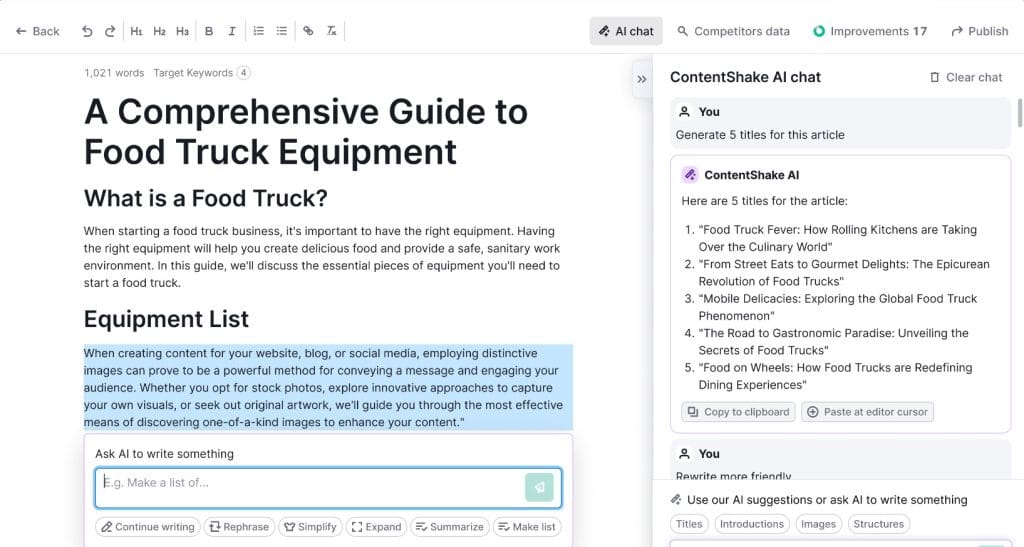
Gumloop can analyze customer support tickets, social mentions, and reviews to identify common pain points your content should address.
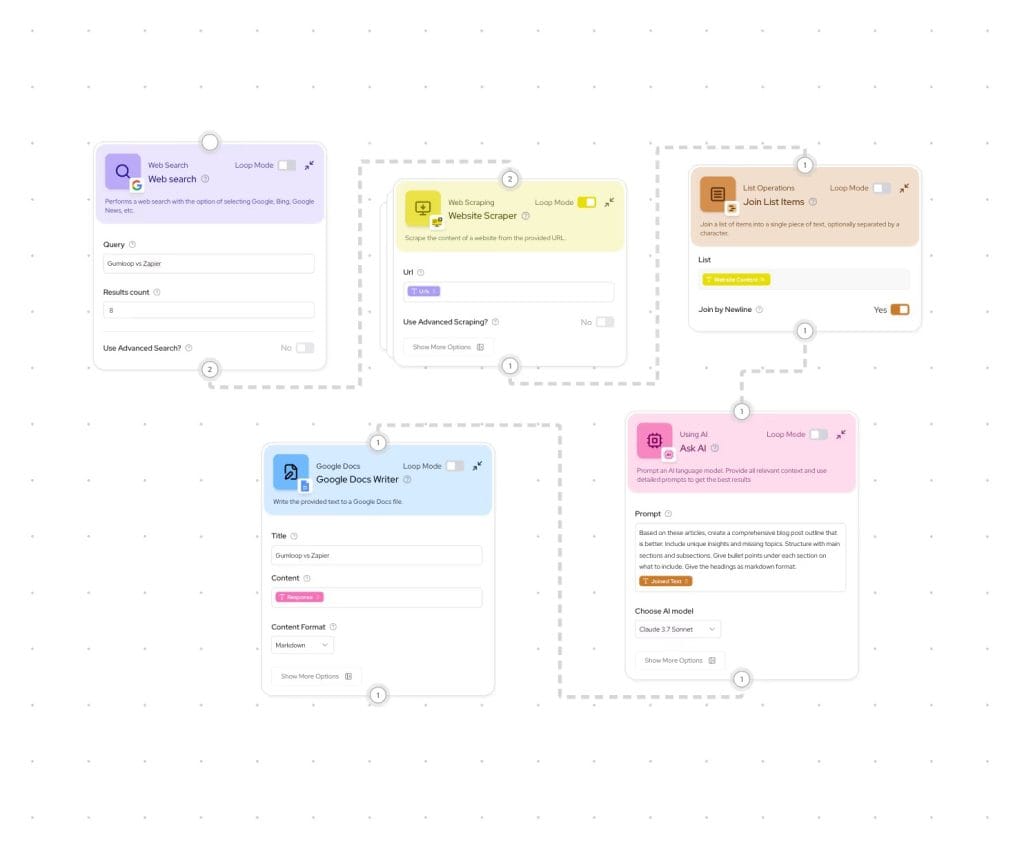
These tools help you create more resonant problem-focused content instead of guessing what matters to your audience.
Metrics That Actually Matter for TOFU Success
Stop measuring TOFU content with pageviews and social shares. Those metrics tell you nothing about funnel progression.
Instead, track things like:
- Problem resonance score: what percentage of audience engages with specific problem statements?
- Consumption completion rate: what percentage completes at least 70% of the content?
- Next-step activation: what percentage engages with “related content” suggestions?
- Return frequency: what percentage comes back within 14 days?
These metrics show you whether content is actually connecting with prospects’ real challenges and moving them forward in their journey.
What metrics are you currently using to measure top-funnel content effectiveness? Do they tell you anything meaningful about funnel progression?
MOFU: Mid-Funnel Strategies That Prevent Lead Drop-Off
The middle of the funnel is where most of your content campaigns probably lose steam. You’ve got prospects who showed initial interest, but they just… disappear.
This happens for two main reasons:
- You try pushing for conversion before establishing sufficient credibility
- You don’t address the psychological barriers preventing decision progression
MOFU
Middle of Funnel
Content that builds credibility and addresses purchase barriers
Consideration Content That Builds Trust and Credibility
This content needs to educate prospects on solution approaches while simultaneously building brand credibility. It’s a tricky balance to achieve.
If you have a management consulting client struggling with leads that express interest but never convert to sales calls, and their content focuses entirely on service features, try creating a detailed breakdown of “The 5-Phase Approach to Supply Chain Transformation” that reveals their unique methodology. You’ll likely see 3x better performance in terms of time-on-page and lead conversion rates.
Strong consideration content includes:
- Methodology explanations that show your client’s unique approach
- Interactive assessment tools that provide personalized insights
- Selective comparison frameworks that highlight differentiators
The key is to start simple and progressively introduce more complexity as prospects engage further. Mix text, visuals, and interactive elements to maintain engagement during longer considerations.
When was the last time you created content that truly explained your client’s unique methodology? This is often the missing link between education and conversion.
Validation Content That Overcomes Purchase Hesitation
Validation content addresses the need for risk reduction and social proof before purchase decisions. This is where many of your funnels might fail through using generic case studies instead of targeted validation content.
For your enterprise software clients, create segmented success stories for different scenarios: “How Companies With Legacy Systems Achieved 6-Month Implementation” and “How Fast-Growth Startups Deployed Within 30 Days.”
This targeted approach can achieve 2.4x higher engagement than generic case studies.
Effective validation content includes:
- Risk reversal frameworks that address specific concerns
- Case studies organized by industry or challenge type
- Content that proactively addresses common objections
The trick is to organize validation content in a “credibility hierarchy” from highest impact (independently verified results) to supporting elements, and to deploy different validation content based on the prospect’s specific concerns.
Do you know the top 3 objections your client’s sales team hears from prospects? If not, that’s your first step to creating effective validation content.
AI Tools That Enhance Your MOFU Strategy
AI tools also transformed how you can create middle-funnel content:
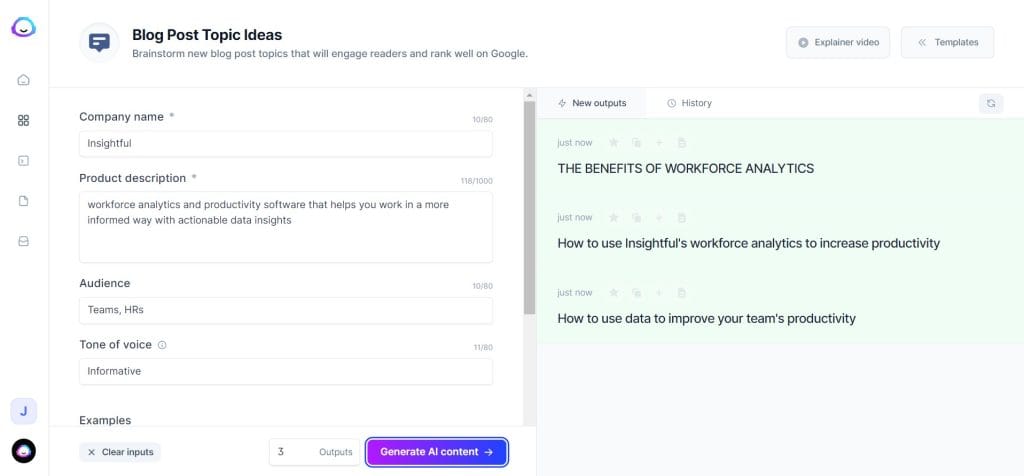
Jasper offers specialized templates for creating detailed comparison content that highlights your client’s differentiators while appearing objective.
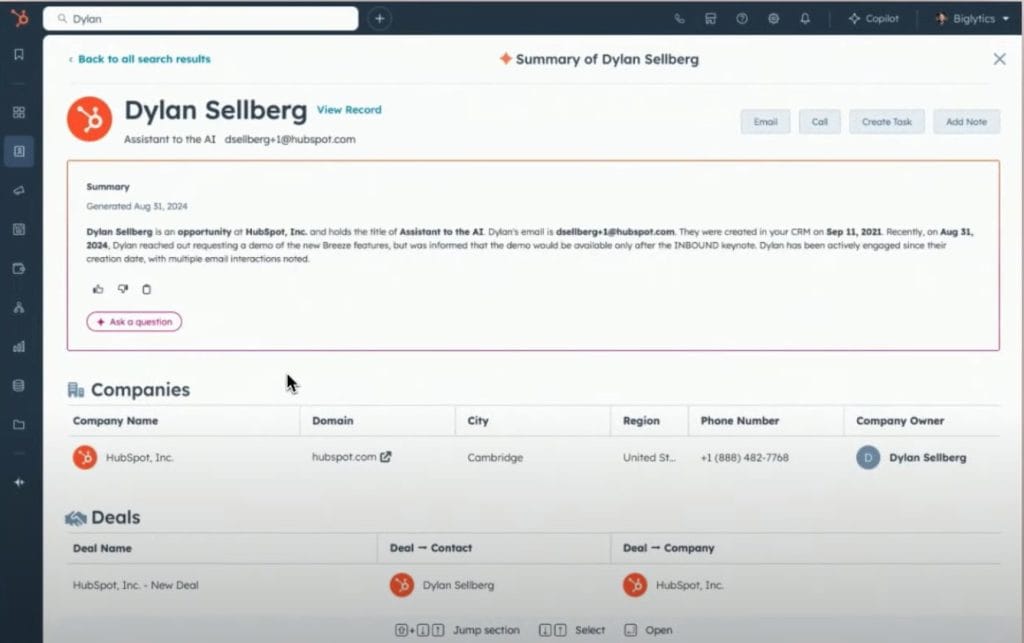
Breeze AI can analyze sales calls and chat logs to identify common objections, then generate targeted validation content that addresses these specific concerns.
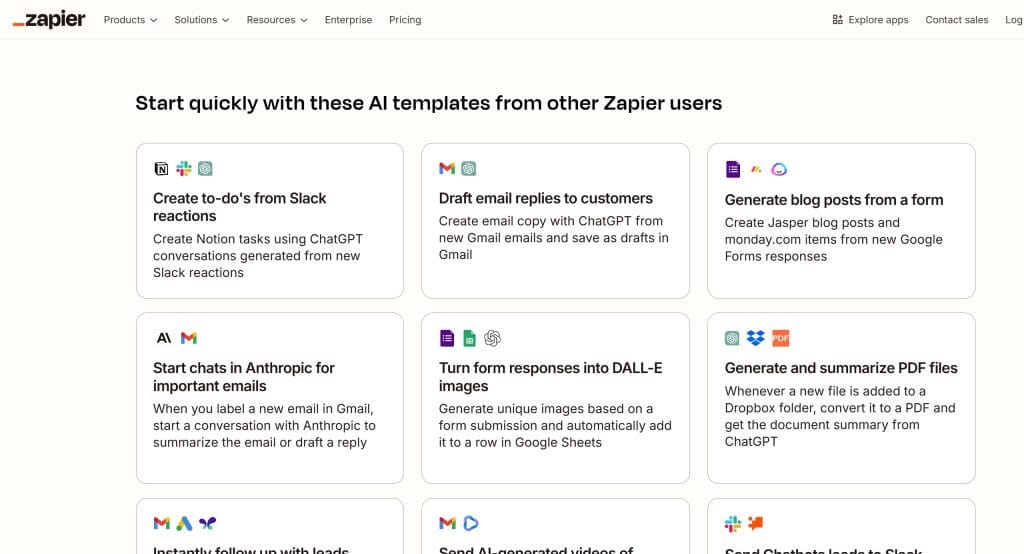
Zapier with AI capabilities can create dynamic content sequences based on prospect behavior, delivering the most relevant consideration and validation content at the right time.
Are you still manually creating generic case studies? AI-powered tools can help you develop targeted validation content that addresses specific prospect concerns.
Advanced Metrics That Reveal MOFU Performance
You might be just looking at conversion rates—a lagging indicator that tells you nothing about what’s actually happening in the middle funnel.
Instead, measure things like:
- Consideration depth: how many consideration-stage pieces does the average prospect consume?
- Validation diversity: how many different types of proof points do prospects engage with?
- Objection resolution rate: what percentage of prospects who encounter objection-addressing content continue in the funnel?
- Decision velocity: how long from initial consideration content to conversion actions?
According to Semrush research, the most effective middle-funnel content types include product overviews (40%), case studies (34%), landing pages (31%), and webinars (31%).
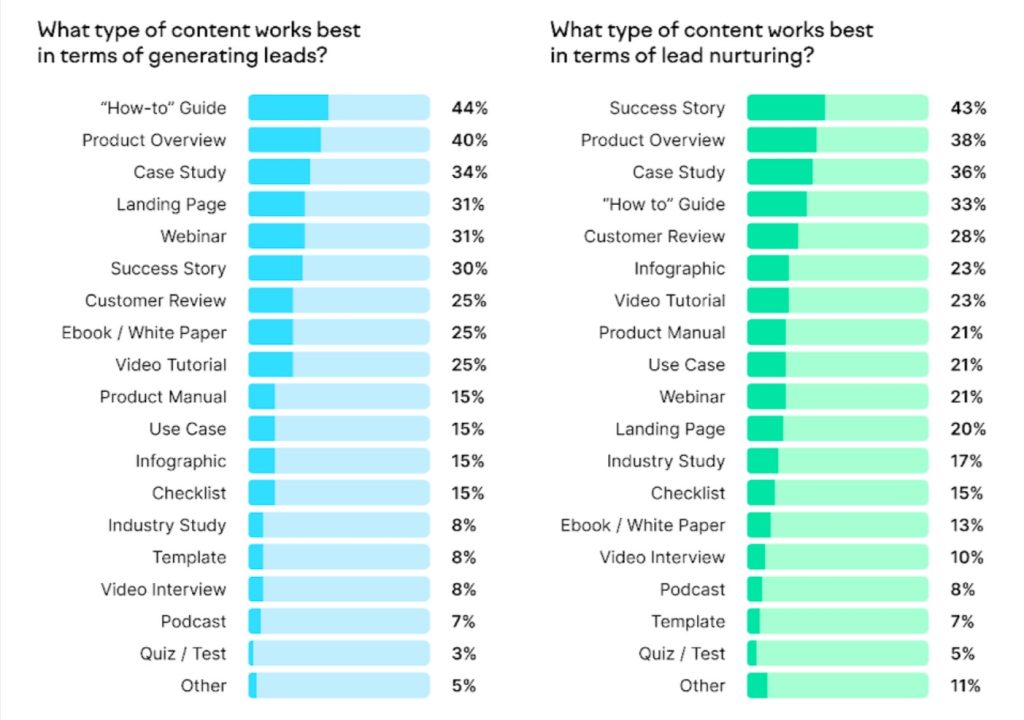
These metrics (below) help you identify specific friction points in the middle funnel rather than seeing it as a black box where leads simply vanish.
| Funnel Stage | Key Metrics | Target Goals |
|---|---|---|
| Discovery | • Problem resonance score • Consumption completion rate • Next-step activation • Return frequency | • 30%+ engagement with problem statements • 60%+ content completion • 20%+ click related content • 15%+ return within 14 days |
| Education | • Content depth engagement • Multi-format consumption • Problem-solution progression • Social sharing rate | • 40%+ explore optional depth content • 25%+ consume in multiple formats • 30%+ move to solution content • 5%+ share with colleagues |
| Consideration | • Consideration depth • Methodology engagement • Competitive comparison interaction • Interactive tool usage | • 3+ consideration pieces consumed • 50%+ engage with methodology content • 40%+ view comparison content • 30%+ use interactive tools |
| Validation | • Validation diversity • Case study engagement • Objection resolution rate • Sales readiness score | • 2+ types of validation content viewed • 45%+ case study completion rate • 60%+ continue after objection content • 70%+ sales-ready qualification |
| Conversion | • Decision simplicity score • Value clarity • Conversion rate • Decision velocity | • 8/10 decision simplicity rating • 75%+ can articulate value proposition • 15%+ MOFU to BOFU conversion • 20% reduction in decision time |
| Implementation | • Time-to-value • Resource utilization • Support ticket reduction • Capability adoption rate | • 40% faster time to first value • 60%+ implementation resource usage • 30%+ reduction in support queries • 50%+ feature adoption in 30 days |
| Amplification | • Advocacy activation rate • Referral generation • Testimonial creation • Retention rate | • 20%+ become active advocates • 1+ referral per 5 customers • 15%+ provide testimonials • 85%+ 12-month retention |
BOFU: Bottom-Funnel Tactics That Close Deals and Create Advocates
You might just hand over “sales-ready” prospects to the client’s sales team and consider your job done. That’s a huge mistake. The disconnect between marketing content and sales process kills conversions.
You need to create conversion content that actively facilitates purchasing decisions.
BOFU
Bottom of Funnel
Content that simplifies decisions and creates advocates
Conversion Content That Makes Purchase Decisions Easier
Good conversion content doesn’t just ask for the sale—it makes the purchase decision clearer and easier.
For your SaaS clients, try creating “The 3 Implementation Pathways: Choosing Your Optimal Getting Started Approach,” which simplifies complex buying decisions into clear, manageable choices.
This simple framework could increase sales call conversion rates by 32% by reducing decision complexity.
Strong conversion content includes:
- Decision simplification frameworks that reduce choices to manageable options
- Value comparison tools that establish favorable perception regardless of price
- Transition maps that show what happens after purchase, reducing uncertainty
The key is to maintain visual and tonal consistency with earlier funnel stages rather than suddenly shifting to “sales mode,” and to simplify decisions to 2-3 clear options rather than overwhelming with complete feature lists.
How many steps does it take for someone to become your client’s customer? Every unnecessary step or decision likely costs them conversions.
Post-Purchase Content That Drives Retention and Referrals
The most overlooked funnel stages—post-purchase content—represent the highest ROI opportunity for you. This content reduces support costs, improves satisfaction, and generates referrals.
For your marketing technology clients, develop a “10-Day Implementation Sprint” guide that helps new customers achieve initial wins quickly. This could reduce time-to-value by 40% and decrease early churn by 25%.
Implementation content includes:
- Quick-start guides for early wins
- Feature mastery sequences
- Materials that help champions justify the purchase internally
Amplification content includes:
- Success narrative frameworks that help customers articulate their results
- Templates for sharing success internally and externally
- Community integration opportunities
Nearly 65% of company revenue comes from existing customers, and loyal customers purchase 90% more frequently than new ones.
Does your content plan currently extend past the purchase? If not, you’re missing the highest-ROI content opportunities in the entire funnel.
AI Tools That Power Your BOFU Strategy
AI tools can make your bottom-funnel content more personalized and effective:
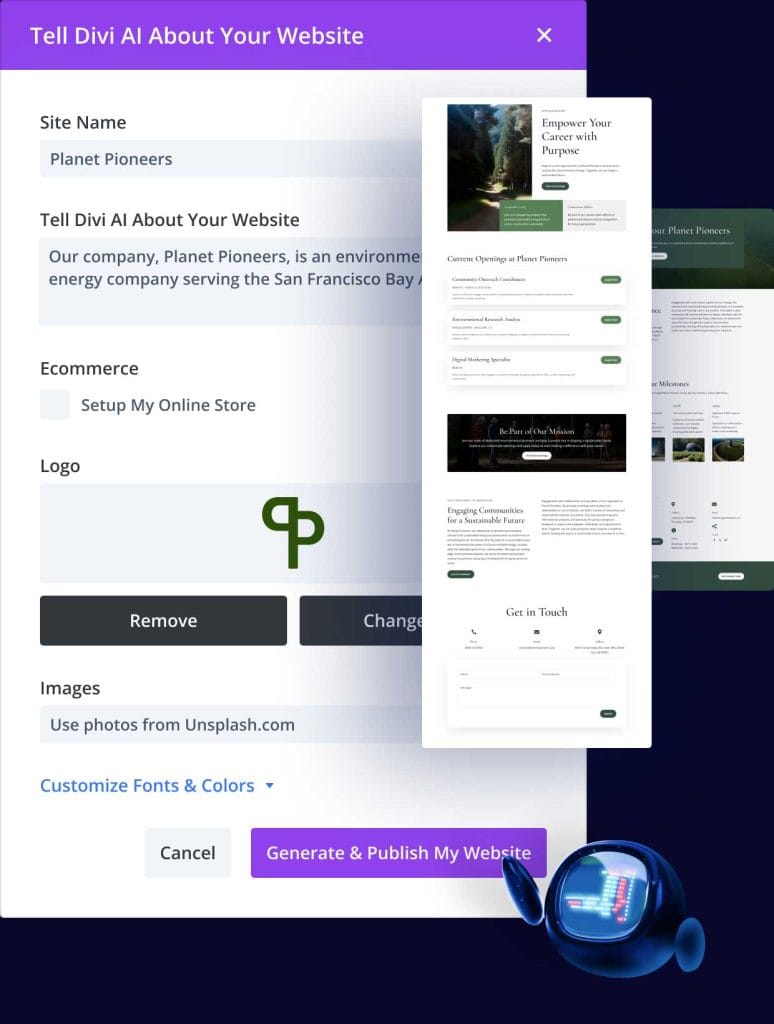
Divi AI creates dynamic decision pathways that adapt to prospect behavior, making purchasing decisions feel simpler.
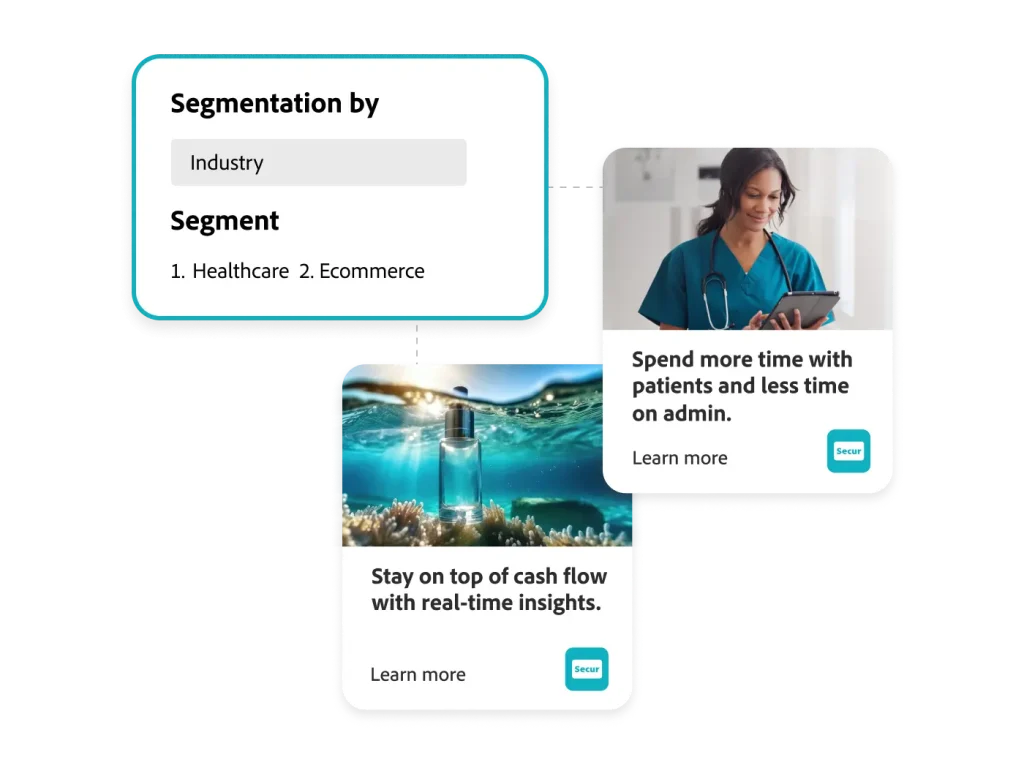
Marketo Engage develops custom implementation content sequences based on customer profiles and likely usage patterns.
These tools help you tailor the conversion and implementation experience to specific prospect and customer needs.
BOFU Success Metrics That Matter
Beyond basic conversion rates, track things like:
- Decision simplicity score: surveyed perception of how easy the decision felt
- Value clarity: percentage who can clearly articulate the value proposition
- Time-to-value: days from purchase to first value realization
- Advocacy activation: percentage who engage in referral activities
Research shows reducing perceived decision complexity, such as, including videos on landing pages can increase conversions by up to 86%.
Agency Operations That Support Effective Funnels
Having a great funnel framework doesn’t help if your team can’t execute it. How do you operationalize content funnels within your agency?
Team Structures That Break Down Content Silos
Your typical agency structure—separate strategy, creative, and distribution teams—probably creates funnel disconnects. Your content creators often don’t understand how their pieces fit into the larger journey.
Consider reorganizing into:
- Funnel ownership teams: cross-functional groups responsible for specific funnel stages
- Funnel strategists: specialists who maintain funnel integrity across touchpoints
- Content journey managers: team members who monitor individual prospect progression
This prevents the common problem of strong top-funnel content with weak middle and bottom-funnel execution. It also gives team members deeper expertise in the psychology of specific funnel stages.
How is your team currently organized? Does your structure support funnel continuity or create silos?
Process Innovations That Maintain Funnel Integrity
Implement these process innovations:
- Content mapping protocols: standard processes for assigning funnel stages to content
- Funnel gap reviews: regular audits to find and fix funnel weaknesses
- Cross-stage handoff procedures: formal processes for transitioning prospects
- Funnel analytics reviews: dedicated sessions to analyze stage-specific metrics
These processes prevent the “set it and forget it” approach that causes funnel degradation over time.
Technology Solutions That Enhance Funnel Performance
You might be underutilizing technology for funnel management. Consider tools like:
- Journey mapping platforms to design and monitor funnel progressions
- Content scoring systems to evaluate effectiveness at each stage
- Progressive profiling tools to build prospect profiles across stages
- Multi-touch attribution models to properly credit touchpoints throughout the journey
The right tech stack gives you visibility into funnel performance and helps identify optimization opportunities.
Client Implementation Framework That Delivers Results
How do you translate these concepts into client-specific strategies? Follow this implementation framework:
Funnel Diagnostic Assessment That Uncovers Opportunities
Before proposing solutions, conduct a comprehensive diagnostic:
- Map existing content to the 7-layer funnel
- Identify missing or underperforming elements
- Document conversion paths and friction points
- Evaluate competitive funnel strategies
This assessment provides the foundation for your recommendations. You’ll probably find most clients have decent awareness content but significant gaps in consideration, validation, and conversion content.
Strategic Funnel Architecture That Maps The Customer Journey
Develop the client-specific funnel model:
- Create journey maps for primary audience segments
- Define specific objectives for each funnel stage
- Match content types to funnel stages
- Establish KPIs for each stage
This architecture becomes the blueprint for all subsequent content development.
Content System Development That Coordinates The Entire Funnel
Transform the architecture into an actionable content system:
- Create comprehensive briefs for each funnel element
- Establish processes for efficient content creation
- Align distribution channels with funnel stages
- Develop testing protocols for key funnel elements
According to WPFunnels, A/B testing is essential for funnel optimization, with 70% of marketers seeing up to 300% improvement in conversion rates through consistent testing.
Performance Optimization That Continuously Improves Results
Implement continuous improvement mechanisms:
- Create visualizations of key funnel metrics
- Establish regular performance review cadence
- Develop processes for addressing funnel weaknesses
- Create a roadmap for funnel evolution
This approach transforms funnel management from a one-time implementation to an ongoing optimization process.
Common Challenges and Practical Solutions
You’ll likely face several challenges when implementing sophisticated funnel strategies:
Client Expectations Management That Sets Realistic Timelines
Your clients want to see ROI within weeks, but good funnel strategies take time to show results.
Solution: Create a “Leading Indicators Dashboard” that shows progress before conversion metrics improve. Include engagement depth trends, content completion rates, next-step activation, and return visitor increases.
This helps clients see momentum building while waiting for sales to catch up. Set clear timeline expectations upfront based on their specific sales cycle.
Team Skill Development That Builds Funnel Expertise
Your content creators are trained in formats (blogs, videos, etc.), not funnel psychology.
Solution: Reorganize teams around funnel stages rather than content types, creating expertise in the psychology and objectives of each stage.
Implement “funnel first” briefing processes that emphasize stage objectives before creative considerations. Develop cross-training programs to build funnel-wide capabilities.
Attribution Models That Prove Funnel Value
How do you prove the value of the entire funnel when most analytics focus on last-click attribution?
Solution: Implement both stage-specific KPIs and cross-layer attribution. Develop proxy metrics for difficult-to-measure touchpoints. Create visualizations that show funnel health beyond conversions.
Content marketers who measure ROI are more likely to generate greater year-over-year returns
Budget Allocation Strategies That Maximize Impact
How do you decide where to focus limited content resources?
Solution: Start with benchmark allocations based on typical funnel performance, then implement real-time budget shifting based on funnel metrics. Develop stage-specific ROI calculations to justify investments.
Which of these challenges resonates most with your agency right now? How might you adapt these solutions to your specific situation?
Your Action Plan for the Next 90 Days
Ready to transform your approach to client content? Here’s your implementation roadmap:
First 7 Days Action Items
- Select one client as your pilot case
- Conduct a content gap analysis using the 7-layer model
- Identify your top 3 high-impact, low-effort opportunities
30-Day Implementation Strategy
- Develop stage-specific KPIs and measurement frameworks
- Create content templates for each funnel layer
- Design your first cross-layer content sequence
90-Day Transformation Roadmap
- Build AI-augmented workflows for content production
- Implement cross-layer attribution tracking
- Create client education materials about funnel expectations
The agencies that master this approach see dramatic improvements in client retention, profitability, and referral business. More importantly, they deliver genuinely better results for their clients.
Which client would benefit most from this approach? What’s stopping you from starting the process today?
Content Marketing Funnel FAQ
Expert answers about implementing advanced content funnels that drive real results
The 7 layers of an effective content marketing funnel are: Discovery (when prospects first recognize they have a problem), Education (when they explore the problem and become aware of possible solutions), Consideration (when they compare different solution approaches), Validation (when they seek social proof and assess risks), Conversion (when they make the actual purchase decision), Implementation (when they start using what they bought), and Amplification (when they become advocates for your client’s product/service).
The traditional awareness → consideration → decision model is too simplistic for how people actually make buying decisions today. It’s like performing surgery with a butter knife. Modern buyers need content that addresses specific psychological stages, provides social proof, guides implementation, and facilitates advocacy. The 7-layer model gives you measurable transitions between stages so you can show clients exactly where progress is happening.
Research shows people typically look at 3-7 different content pieces before making a significant purchase decision. The average B2B decision involves at least 6 sessions across 2-3 different devices. Most importantly, prospects need exposure to at least 4 content pieces from the same source before they consider that source trustworthy enough to buy from. MarketingProfs claims it takes 13 pieces of content before making a buying decision.
No. Real buyers don’t move linearly through content—they bounce around, revisiting stages multiple times. They don’t proceed in a straight line but explore content across multiple devices and sessions. Your funnel architecture must account for this messy reality with content that works for non-linear progression, repeated evaluation cycles, and cross-device experiences.
Implementing sophisticated funnel strategies delivers: 40%+ better client retention rates, 30-45% faster time-to-profitability on campaigns, and premium pricing power (30-50% above market average). Content marketing costs 62% less than traditional marketing while generating 3 times as many leads. Without a proper funnel strategy, though, those leads don’t convert, and clients don’t see ROI.
If you can’t show clear ROI from content within 6-9 months, you’ll likely lose clients before campaigns become profitable. That’s the brutal reality of agency economics. Create a “Leading Indicators Dashboard” that shows progress before conversion metrics improve—tracking engagement depth, content completion rates, and return visitor increases to demonstrate momentum while waiting for sales to catch up.
Stop measuring with just pageviews and social shares. For top-funnel, track problem resonance score (engagement with problem statements), consumption completion rate, and return frequency. Middle-funnel: consideration depth, validation diversity, and objection resolution rate. Bottom-funnel: decision simplicity score, time-to-value, and advocacy activation. These metrics reveal specific friction points rather than seeing your funnel as a black box where leads vanish.
It costs between $11,000 to $15,000 to acquire a new agency client according to Instapage. Even worse, about 68% of client relationships end within the first 12 months because clients don’t see “measurable results.” Each client that leaves represents thousands in sunk costs and tens of thousands in lost future revenue. Effective funnel strategies dramatically improve retention and profitability.
The best Discovery content focuses on helping prospects recognize their problems, not your solutions. Create problem assessment tools that quantify issues, diagnostic quizzes that help prospects self-identify challenges, and comparative calculators that show the cost of doing nothing. This content should be ungated to avoid creating psychological barriers at this early stage.
The biggest mistake is focusing on the brand instead of the prospect’s problems. No one wakes up thinking, “I need to learn about XYZ company today.” They wake up with problems they need to solve. If you have a client insisting on “raising brand awareness” with content about their company, redirect them to creating content that addresses specific customer pain points instead.
Instead of generic case studies, create segmented success stories for different scenarios: “How Companies With Legacy Systems Achieved 6-Month Implementation” and “How Fast-Growth Startups Deployed Within 30 Days.” This targeted approach achieves 2.4x higher engagement than generic case studies. Organize validation content in a “credibility hierarchy” and deploy different validation content based on the prospect’s specific concerns.
Good conversion content makes purchase decisions easier, not just asks for the sale. Decision simplification frameworks that reduce choices to 2-3 clear options can increase sales call conversion rates by 32%. Value comparison tools and transition maps that show what happens after purchase also work well. Maintain visual and tonal consistency with earlier funnel stages rather than suddenly shifting to “sales mode.”
Post-purchase content (Implementation and Amplification stages) delivers the highest ROI. Nearly 65% of company revenue comes from existing customers who purchase 90% more frequently than new ones. Quick-start guides can reduce time-to-value by 40% and decrease early churn by 25%. Success narrative frameworks help customers articulate their results and become advocates, generating referrals.
Replace traditional silos (separate strategy, creative, and distribution teams) with funnel-focused structures: funnel ownership teams (cross-functional groups responsible for specific funnel stages), funnel strategists (specialists who maintain funnel integrity), and content journey managers (who monitor prospect progression). This prevents strong top-funnel content with weak middle and bottom-funnel execution.
Follow this framework: First, conduct a Funnel Diagnostic Assessment (map existing content to the 7-layer funnel, identify gaps). Second, develop a Strategic Funnel Architecture (journey maps for audience segments, specific objectives for each stage). Third, create a Content System (comprehensive briefs, distribution channels). Finally, implement Performance Optimization (regular reviews, processes for addressing weaknesses).
For top-funnel: ContentShake AI identifies questions your audience is asking, while Gumloop analyzes support tickets to identify pain points. For middle-funnel: Jasper creates comparison content that highlights differentiators while appearing objective. Breeze AI analyzes sales calls to identify objections. For bottom-funnel: Divi AI creates dynamic decision pathways, while Marketo Engage develops custom implementation content.
Show them the financial impact: 68% of client relationships end within the first year because clients don’t see measurable results. Create a 90-day action plan starting with a content gap analysis using the 7-layer model, then implementing stage-specific KPIs and content templates. Develop client education materials about funnel expectations and create a “Leading Indicators Dashboard” to show progress before conversion metrics improve.
First 7 days: Select one pilot client, conduct a content gap analysis using the 7-layer model, identify your top 3 high-impact opportunities. First 30 days: Develop stage-specific KPIs, create content templates for each funnel layer, design your first cross-layer content sequence. By 90 days: Build AI-augmented workflows, implement cross-layer attribution tracking, create client education materials about funnel expectations.
Show clients the real impact of your content funnels with clear KPI reporting.
Start Your Free Trial Today